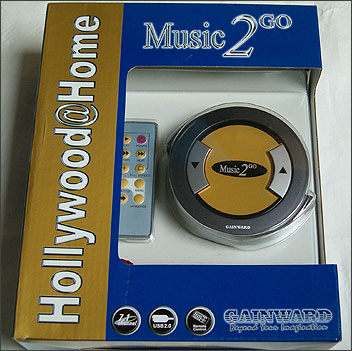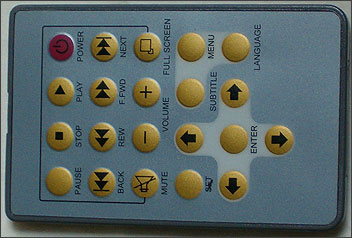Gainward Hollywood@Home Music2Go
The Music2Go is the next Hollywood@Home device that seeks to do just what the TV2Go does, only with audio. Completely USB2.0 bus powered, the Music2Go packs a 7.1 positional audio CODEC into a compact space, offering digital output via S/PDIF into the mix, along with a cute remote control. Let's take a closer look.The unit itself isn't that thin, but its circular dimensions make it fairly compact in use. It shouldn't have any problem slotting into a compartment of your laptop bag if you're a mobile user.
You can see the main volume controls on the top of the unit, either side of the centre. The connectors for speakers, headphones, inputs and USB are around the circumference.
You can see the 7.1 3.5mm speaker output jacks on the right with the small powered USB2.0 port on the left. Line input, microphone input and dual purpose headphone/digital output are on the other side.
The remote is similar to that shipped with the TV2Go, only even smaller.
It handily controls the volume on the Music2Go and also fully controls the copy of WinDVD 5 that Gainward also supply. It also, although semi-limited, controls TV2Go (and the TV2Go's remote controls the Music2Go), so if you have both products you only need the TV2Go remote for full functionality over both devices.
The bundle is otherwise bare, bar the USB data cable. Cables will come with your connected audio devices, be they speakers or headphones, a mic or line input for recording. Software is a simple driver for the C-Media CMI106 Xear3D hard/soft solution that powers the Music2Go. When plugged in, four blue LEDs in the case under the Music2Go logo flash in time to the music. I wasn't able to shut that functionality off obviously within the controlling software. There's also a set of tabs in the driver to make more use of the hardware, such as a karaoke function called Magic Voice that tries to filter out lyrical music data, leaving just the underlying music.
Testing that out I played a copy of Alphabet Aerobics by Blackalicious through the software and rapped my fat white arse off, badly. Fun stuff and utterly hilarious, adding a little bit of extra value to the whole package.
The driver is a piece of cake to setup, the controls for the speaker positioning, jack assignment, digital output and volume controls all colourful on a purple background, drawn well and well laid out.
As for actual audio quality, the C-Media hardware and DACs used seem to be capable of 16-bit at 48KHz output on all eight channels, so in terms of basic specs things aren't bad. Connecting a set of future-review sample Creative GigaWorks S750 speakers to the Music2Go showed some slightly quirky artifacts (slight clipping of the bass signal that isn't present on my other sound hardware), but easily enough for a subjectively good listening experience using mid-range consumer audio speakers, the GigaWorks and a set of loaned low-end Sennheiser cans (you know who you are!).
Being completely powered by the bus is the Music2Go's main selling point, making it appeal largely to laptop and other mobile users. Even desktop users looking for something to partner an XPC or upgrade their horrid on-board audio should be keen. CPU usage isn't massive and any recent CPU shouldn't have you noticing the performance hit too much.
It's no audiophile soundcard replacement, but as a niche device for bringing multi-channel positional audio to mobile users, it hits the spot.













